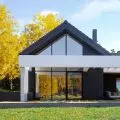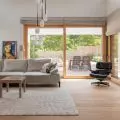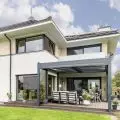Conversion and expansion of the 1938 garage halls for the Pomeranian Science and Technology Park in Gdynia
The principles of the new approach to the protection of the monuments of modernism were implemented in the project for the reconstruction and expansion of the garage halls in Gdynia. The project was carried out by implementing in sequence:
- Removal of extensions to the original building with their traces left on the old structure.
- Opening up the mass by further removing unnecessary elements of the original object.
- Arrangement of the new function and composition of movement in the space.
- Composition of space in a spatiotemporal rhythm - incorporation of new elements according to the principle of architecture described by Strzeminski: "Spatial architecture is a composition of divisions of space in three dimensions. The rhythm of divisions, growing, goes beyond a given building complex, connecting with another. Thesize and direction of the divisions, the energy of color and light, the energy or static of the texture (e.g., in installations) are coefficients of this rhythm, dynamizing or restraining it. "24
Opening up the massing of the historic original
Based on the original design from 1938, the original shape of the building was reconstructed. Then the reinforced concrete columns and massive reinforced concrete beams of the skeletal structure were exposed by removing the walls and extensions that meet them. Open corridors running in the axes of the columns "across" the entire building were obtained. There was an opening of the mass, the reinforced concrete structure with a span of 25 meters between the columns showed its beauty. After cleaning the reinforced concrete from multiple layers of paint, the original texture of the concrete and the imprint of the formwork planks were obtained. A modernist honesty of the material's appearance was created. Scratches and cracks revealed the workings of the structure. Most interesting were traces of fastening techniques, its historical development: blocks, pegs, anchors, and traces of installation of installations and partitions.
archival photograph of a garage hall in Gdynia in 1939 and models of the successive stages of the project for its redevelopment into the Pomeranian Science and Technology Park (PSTP); author of the project arch. Paweł Wład Kowalski with the team of KOWALSKI ARCHITEKCI and W. M. Pracownia Projektowania Miasta - Gdańsk
archival photograph of the hall from 1947 (author unknown), photograph from 2002 before the project was undertaken, photograph of the completed reconstruction of the hall for PPNT - 2008
photo: Pawel Vlad Kowalski
Composition of movement of the new function
The building functions as an "invention incubator." Its new function is in keeping with the spirit of modernism, and is intended to further inspire further modernization of life. The new functions have been arranged in such a way as to arrange around a common corridor, a road running down the middle of the hall, meeting places, display of achievements and intimate work areas. Routes of movement and stops were delineated, the basis of architecture according to the principles of Kobro and Strzeminski "The purpose of architecture is to organize the rhythm of successive movements and stops, and thus to form the whole of life. "25
Elements of composition construction
For the elements of the new composition carried out in a space-time rhythm, the sincerity of the appearance of the structure and the materials used is mandatory, everything is on top, installations, cables, pipes, textures of old concrete and modern formwork systems. Unplastered concrete, board cladding, cement-lime block walls, sheet metal, create interior compositions with their natural appearance do not imitate anything, do not pretend. When everything is available, you can easily adapt rooms and areas for a change of function. Movement, changeability of function, adaptability are important features resulting from the postulates of the avant-garde.
PSTP - main entrance
photo: Paweł Wład Kowalski
The idea of the rhythm of the composition
New elements are inserted into the interior of the hall and separated from it, so that between the old and the new a relationship is created through compositional contrast. Platforms of new utility levels were inserted into the hall. Inside it, an autonomous arrangement of space has been created with new elements, which move from the urban interior to the interior directing the user's movement. Architecture within architecture is being created. The leitmotiv of this composition is the idea of a wave, which as a form of existence of matter, energy, nature, is the denominator that unites what explorers and scientific research companies do. Light, sound, electricity, water, earth, air.... A ripple occurs everywhere. The cradle roof, the arched canopies, the undulation of the ground, the gaps in the new reinforced concrete wall allude to the spectral splitting of light. The rippling of the water is imitated by polers - reinforced concrete columns. The new walls like ribbons delineate the space of movement. A compositional play of textures and colors was created, color is, after all, also a wave of light.
Completion
The application of the principles of spatio-temporal rhythm is easy in adaptations and remodels. In the existing space it is easier to move and further compose. There is a clear point of reference. It is more difficult when the square is empty and we are facing a new project. But we always come from somewhere to this place and bring something with us. We never work on a raw root. In our imagination we can recreate the ever-living trunk of great classical architecture, which will bear, even after the greatest deviations, excellent fruit. Awareness of its existence is enough to base one's work on it. It is worth taking up the precious heritage of the Polish modernist avant-garde to inspire the realization of modern architecture and find its rightful place in the history of art and architecture.
Pawel Vlad KOWALSKI
1. by W. Strzeminski "Balance of modernism" "Europe", 1929, no. 1, pp. 22-24
2. communication of the Group "A.R." No. 1, "Europe", 1930 No. 9, K. Kobro, J. Przyboś, H. Stażewski and W. Strzeminski
3. W. Strzeminski "Object and Space" - published in "Wiek XX", 1928, no. 21
4. W. Strzeminski, Sz. Syrkus. "The present in architecture and painting". - Art Review, 1928 no. 4
5. H. Syrkus "Towards the idea of social settlement 1925-1975" PWN Warsaw 1976 pp. 27
6. S. Syrkus, "Architecture opens the block" Machine Age Exposition catalog, New York 1926 - after information given by H. Syrkus "Towards the idea of a social settlement 1925-1975" PWN Warsaw 1976
7 W. Strzeminski, Sz. Syrkus. "The present in architecture and painting". - Art Review, 1928 no. 4
8. H. Syrkus "Towards the idea of a social settlement 1925-1975" PWN Warsaw 1976 pp. 28
9. W. Strzeminski "Object and space" - published in "Wiek XX", 1928, no. 21
10. A. Paluszewski "a. r. myth urzeczniony dzieje i kolekcja", Lodz publishing house 1989
11. W. Strzeminski "Principles of new architecture" "Line". 1931 no 3
12. W. Strzeminski "Modern art in Poland" text in "On modern art" Lodz. 1934
13. K. Kobro, W. Strzeminski "Composition of space..." see description of illustration 2. Project of composition of a residential interior
14. W. Strzeminski "Theory of Seeing" Wydawnictwo Literackie Krakow 1958
15. K. Kobro "Functionalism", Forma, Lodz 1936 no. 4
16. K. Kobro, W. Strzeminski. "Composition of Space. Calculations of space-time rhythm" Library a.r. No. 2, Łódź 1931
17. J. Zagrodzki "Inside space" text in the book "Katarzyna Kobro in the hundredth anniversary of birth 1898-1951" Łódź 1999
18. K. Kobro "Sculpture constitutes..." Głos Plastyków 1937 nr 1-7
19. A. Turowski "Theoretical Rhythmology, or the fantastic world of Katarzyna Kobro" text in the book "Katarzyna Kobro in the hundredth anniversary of her birth 1898-1951" Łódź 1999
20. B. Kowalska "Katarzyna Kobro. Sketch on precursorism" text in Nika Strzeminska's book "Katarzyna Kobro" Scholar, Warsaw 1999
21 K. Kobro W. Strzeminski "Composition of space..." Łódź, 1931
22. ibid
23. Paweł Wład. Kowalski "Between culturism and naturism", Arche Warsaw 1988
23. W. Strzeminski "Principles of new architecture" "Line" 1931 no. 3
25. W. Strzeminski "Principles of new architecture" "Line" 1931 No. 3






















































